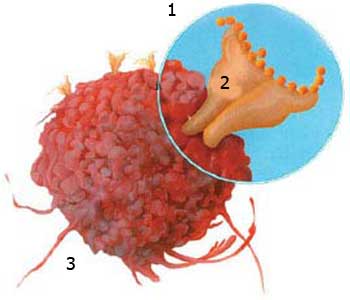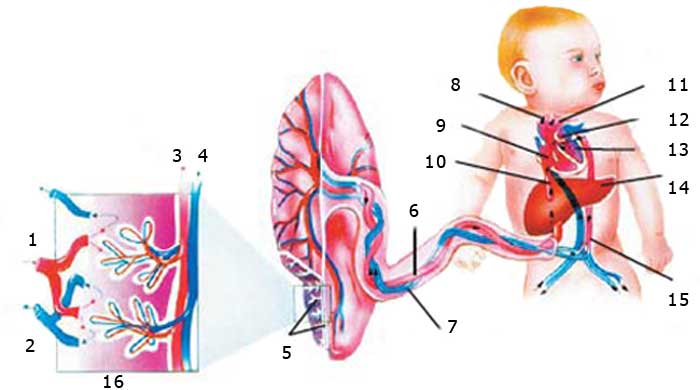Microscopic living things that do not belong to the body itself can enter it by one means or another, and thus set the body's defense forces in motion. Certainly, not every foreign substance that enters the body is treated as an enemy. Substances with foreign properties enter the body every time we eat, take medicines or drink water. Yet our bodies do not declare war on these substances. In order for the defense cells to regard a foreign substance as hostile, certain conditions must be fulfilled: such as the size of the "foreign" molecule, the speed of expulsion from the body, and the way it entered.60
 |
| The theory of evolution assumes life developed from a "simple" cell but science today demonstrates that there is no such thing as a simple cell. Howard Peth |
T cells play the main role in the immune system's fight against viruses and other microbes. T cells begin their life in the bone marrow. After receiving an enemy warning, immature ones head for the thymus gland to acquire more expertise. In order for T cells to be useful, they need to be added by means of receptors to the antibodies targeted against specific microbes.
 |
| 1. Antigen peptide section |
| The task of the antigen identification cells is to offer the antigen (enemy) to the T cells. This is a most serious responsibility. That is because the antigen identifying cells know that the T cells will defend the body, and they pass the enemy they catch on to the T cells for intelligence to be gathered. It is impossible for a cell to undertake such a responsibility and to serve a system for the defense of the body by coincidence. It is Almighty Allah Who inspires these responsibilities in the cells. |
Cells in the immune system such as T cells use recognition proteins like molecular flags and signposts to determine whether a cell belongs to the body. These proteins enable cells to recognize and make contact with one another. The rod-like extensions (molecules containing sugar and known as glycoprotein) of these proteins protrude from the cell membrane to the outside.
Recognition proteins make it possible for sperm cells to recognize an egg cell of the same species; they also permit viruses and bacteria to determine the right cells to attack and form areas where one cell can bind to another. Toxins bind to recognition proteins in order to kill cells. Since the wrong recognition proteins are present in transplanted organs, the body rejects these tissues unless its immune system is suppressed.
The absence of recognition proteins plays an important role in the formation of cancer. By means of the recognition proteins, connections normally develop among cells that regulate cellular growth. Cancer cells, however, evade these precautions to form tumors or metastasize, spreading cancer cells throughout the body. Cancer cells can also produce recognition proteins seen in other types of cell, and use these false proteins to assist their metastasis.
Very few recognition proteins are peculiar to cancer cells, so the immune system does not identify them as cells needing to be destroyed. Cancer researchers' basic aim is to identify the recognition proteins peculiar to cancer cells and to increase their number, so that the immune system can identify the tumor as foreign and destroy it. Knowing the structure of cancer cells' recognition proteins could also make possible special drugs for these proteins and specific cancer cells.
In the event of an injury to tissue, immune system reactions begin. Defense cells known as macrophages identify the location and counterattack the invading microbes as quickly as possible. This makes it possible for the body to withstand the countless dangers it is exposed to every day.
A T cell identifies a location, analyzes the situation posing a threat and takes necessary precautions by sending messages where required—all exceedingly conscious behavior. No cell thought of these duties by itself. To say that your body developed this life-saving system by chance flies in the face of reason and logic.
| Your Body Contains Cells With An Awareness That Defends You From Attackers. This Consciousness Observed In The Cell Is An Inspiration From Allah | ||
 |
The diagram shows how the defense system cells neutralize a bacterium. The communication among cells possesses a complexity that has occupied scientists for decades. Darwinists' evolutionary mechanisms cannot account for the existence of a special language between cells and molecules, nor the way that the molecules and cells take appropriate measures in the light of this, nor how they initiate hostilities against a foreign invader. Darwinist scientists are baffled in the face of the reason and consciousness manifested in the cell through the inspiration of Allah. | |
| 1. Endocytosis sacs | 4. MHC protein | 7. Receptor |
Also important is that normally, most macrophages have encountered such an attack for the first time. Cells with no prior training can evaluate the situation of which they have no previous knowledge, and distinguish between what is dangerous and what is not. This can't possibly be the result of coincidence. This perfect system is a great blessing from our Lord, the Compassionate and Merciful, as well as being an example of His omniscience. (For details, see Harun Yahya, The Miracle of the Immune System.)
An egg cell fertilized by a sperm or zygote, begins rapidly dividing into two cells, then four, then eight. To do this, it requires large quantities of nutrients. In order to take nourishment from the mother, some of the embryo's cells form the placenta, a structure that permits the exchange of foodstuffs, oxygen and other substances between mother and her baby. In order to constitute new cell groups—tissues, in other words—the placenta carefully selects the right nutrients and oxygen, and in carrying these to the fetus, the placenta also separates out waste products to be sent out of the mother's body.
Placental cells know what the baby will need and when. They take the necessary measures in the light of that need, select the needed substances and remove unnecessary ones from the baby. This they do day and night without rest—an extraordinary phenomenon. Not even a doctor equipped with the latest medical knowledge could assume such a responsibility. However, Allah reveals to us His matchless artistry by equipping the placenta cells with their most superior ability.
 | ||
| 1. Blood from the mother | 6. Artery connected to the abdomen | 11. Left auricle |
| The fetus is connected to its mother's placenta and is nourished by substances reaching it from its mother's blood. However, it is most important that the defense cells in the mother's blood should not also reach the embryo. Indeed, cells in the placenta's structure perform exactly that function. Fine gaps between these cells permit the passage of nutrients that the embryo needs. But since the mother's defensive T cells cells are larger, they are unable to pass through. For us to survive, more systems need to be present than we can possibly list here. Each of these flawlessly created details is an act of mercy from our Lord, with His superior intellect and knowledge. | ||
The womb is filled with amniotic fluid that protects the fetus. It is impossible for a baby to grow in its mother's womb in the absence of amniotic fluid, through which both mother and child are protected. At 12 weeks of age, the fetus's own circulatory system has developed. However, it still depends on its mother's bloodstream to receive oxygen and nutrients and to expel carbon dioxide and waste products. The exchange that takes place between their two circulatory systems must occur without the two blood supplies becoming intermixed up, or the results could be fatal.
The placenta flawlessly separates the circulatory systems of mother and fetus. Gasses, foodstuffs and wastes are exchanged between the mother's and the fetus's blood. However, these physical barriers—separate circulatory systems and amniotic fluid—are not sufficient by themselves for the baby's survival. 61
How Does The Embryo Evade Its Mother's Immune Cells?
The mother's immune system does not reject the foreign tissue—the embryo, which represents a foreign substance—inside her body. In the same way that foreign tissue is rejected by organ transplant patients, so the embryo should be regarded as a foreign body by the mother's immune system. Half of the unborn baby's genes come form the mother and half from the father, and every compound from the father should be regarded as an antigen or attacker. Therefore, one would expect the defense system to set about eliminating the embryo.
However, the mother's body does not declare war on the embryo, because the components of the immune system in her blood are not permitted to pass through the placenta; and so these elements cannot perceive the embryo as a foreign tissue and destroy it.
The defensive cells standing guard in the body become acquainted with foreign substances before moving to destroy them. To do this, they use molecules known as the major histocompatibility complex (MHC) in the cell membrane. Since the embryo's cells do not have the MHC molecules, they are not identified by the mother's defense cells. However, the absence of MHC molecules in these cells can lead to natural killer cells determining that these cells are abnormal and destroying them. Therefore, the embryo cells carry a non-classical type of molecule in their cell membranes: human leukocyte antigen G (HLA G).
Therefore, the mother's defense system does not perceive the embryo's HLA G as a foreign substance, and the natural killers ignore it. Yet in addition to these methods, chemical signals are also employed. The placenta produces a series of chemical signals that affect the mother's defense system, which is why the mother is more exposed to infections during pregnancy.
If this exception were to apply to any other foreign substance in the mother's body, then she would be exposed to lethal dangers. On the other hand, if this exception did not apply to the embryo, then its survival would be impossible. As revealed in the verse "He is Allah—the Creator, the Maker, the Giver of Form ... " (Surat al-Hashr, 24), every detail reveals the perfection in our Lord's creative artistry.
(Bea Perks, Andrew Coulton, "The Great Escape," New Scientist, Vol. 171, No. 2308, 15 September, 2001.)
Examined more closely, the placenta is seen to consist of trophoblast cells, which comprise this wall, a barrier specially created for the blood. The embryo is closely connected to the mother's tissues. On the one hand, the embryo is nourished by substances in the blood arriving from its mother, and on the other, it is under threat from the mother's defense cells. That is because the mother's body regards the embryo as a foreign body that might be an enemy. Therefore, it is vital that the defensive cells in the mother's blood should not reach the embryo. However, the placenta possesses a special Creation that prevents the cells in the mother's blood reaching the fetus. Oxygen, foodstuffs and minerals from the mother's blood pass through these small gaps to reach the embryo. Defense cells, being larger, cannot pass through this barrier.
How is it that the placental cells know that the fetus needs these substances in the mother's blood, and not others? How do they separate and distinguish between the two? How do they know to comprise a structure that protects the baby from its mother's immune system? Clearly the baby is specially protected in the mother's stomach. The placenta cells have assumed this responsibility under the inspiration of Allah.
 | |
| He is Allah —the Creator, the Maker, the Giver of Form. To Him belong the Most Beautiful Names. Everything in the heavens and Earth glorifies Him. He is the Almighty, the All-Wise. |
Whenever you cut yourself, leukocyte cells sacrifice themselves to protect you from invading bacteria. These self-sacrificing macrophages emit large quantities of alarm-chemicals that call the immune system for help.
Immunologists have long puzzled how the macrophages identify invaders. The secret, say Arturo Zychlinsky from New York University Medical School is the lipoproteins found on the surface of almost all bacteria. Zychlinsky exposed macrophages to bacterial lipoproteins and discovered that these immune cells have a "death receptor" that recognizes lipoproteins. When these bind to the receptor, a suicide order is issued within the cell instantly, triggering pre-programmed cell death. The death receptor provides a short cut, speeding up inflammation before the bacteria can gain a foothold. 62
Waste products from cells that commit suicide are immediately destroyed by neighboring cells. But even more astonishing is that not all the dead cells get cleaned up. Tissues such as the lens of the eye consist of dead cells, but these are not eliminated because they are necessary for the body. Some dead cells are deliberately left in place, because their functions in the body are not yet finished. The trillions of cells in the body decide which dead cells to destroy and which to leave.
What gives a cell the awareness to act on such a vital decision? The answer is that all cells have been programmed in the ideal way for their organism to survive. The author of that programming is our Lord, Whose matchless Creation and omniscience can be seen in every detail of life.
It is essential that cells be well cleaned of useless or even harmful proteins. For example, when cells need to stop dividing, they must destroy the proteins that stimulated that division. If they do not do so, then uncontrolled division of cells leads to cancer. Thus, the correct proteins needs to be eliminated at the right time. This process is important in all areas from the fetus's development process to the immune system's defense against microbes. Furthermore, protein decay takes place just about everywhere in the body, and these defective proteins also need to be cleaned away.
Biologists have established that proteins exposed to trauma form pockets with a specific shape. For more than ten years now, we have known that the breakdown of proteins plays a vital role in a cell's life cycle.
When a cell decides to destroy any protein, the cell labels it with a small molecule known as ubiquitin. The cell then separates this labeled protein into its components. To prevent the wrong proteins being labeled, the ubiquitin is accompanied to the right target. After the label has been attached, the target is destroyed: There can now be no going back. Cells use different enzymes to be certain that the right proteins are destroyed at the correct time. 63
Who decides that a protein's defective structure or aspects are harmful to the cell, and how? Whose consciousness orders these proteins to be eliminated? How was it learned that failure to act on that decision would have dangerous consequences for the cell? How does the cell arrive at labeling proteins so that no error should be made? The answer to all these questions is the superior intellect and consciousness of our Lord, Who created the Earth and skies.
60. C.A. Janeway, Jr., "How the Immune System Recognizes Invaders," Scientific American, No. 269(3), September 1993, pp. 72-79.
61. Bea Perks, Andrew Coulton, "The Great Escape," New Scientist, Vol. 171, No. 2308, 15 September 2001.
62. Andy Coghlan, "Secrets of the suicidal blood cell," New Scientist, Vol. 167, No. 2248, 22 July 2000, p. 15.
63. Reto Kohler, "Chuck it out," New Scientist, Vol. 166, No. 2242, 10 July 2000, p. 28.